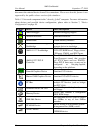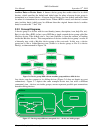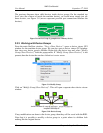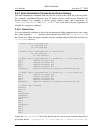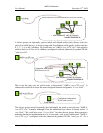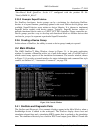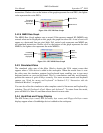
AMD Confidential
User Manual September 12
h
, 2008
22 Chapter 3: Graphical User Interface
Figure 3-13: Children of DIMM Device Group
If we looked at the options and configuration of the device library “-> Machine #1 ->
Dimm DDR2 1GBx2 #0 -> Dimm Bank #0” (either from the GUI or from the console),
we would see that it is already configured as DDR2 with 2 dimm slots (1GB each).
This example demonstrates a broad concept. An existing device that has a more generic
and abstract definition (such as a non-configured “Dimm Bank”) can be wrapped in a
device group to give it an identity as a particular hardware implementation (such as an
already configured “Dimm DDR2 1GBx2”). More generally, any device can be wrapped
by a device group, to give an alternate default configuration for the device‟s state
(archive data).
3.3.5.2 Example: Quad-Core Node
Next we will consider examples relevant to the ability of a device group to have multiple
child devices, default archive data for each child device, and connections between the
child devices. These next examples are based on a quad-core processor node.
Building a processor node in SimNow has traditionally been a multi-step process. First
the user would add the "AMD 8th Generation Northbridge Device", and then add one
"AweSim Processor" device for each processing core in the node. These devices then
need to be connected together along the respective "CPU Bus" and "Interrupt / IOAPIC"
connection ports. Once the devices are connected, a user would then need to load a
product ID file so that the simulated devices would represent a real and planned piece of
hardware. In summary, building a Quad-core node in SimNow could take as many as 14
individual steps, and these steps would need to be repeated each time a processor node is
to be added.
A device group can both simplify adding a quad-core node, and present the user with a
hierarchical view. So we will give some examples with quad-core processor nodes.
A device group is not required to specify archive data for its child devices. When such a
known device group is instantiated as a created device, it simply lets its children use their
own default and initial configuration state. We can create an abstract or generic “4 core
Node” device group that does not represent a particular hardware implementation (just
like a non-configured “Dimm Bank” does not represent a particular hardware
implementation, until it is configured).



